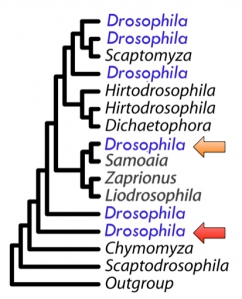Fly world set abuzz by proposal to rename Drosophila
- Trespassers won’t be prosecuted: do you have a right of access to the beach? - 25th March, 2024
- Why do boomers like minions? - 6th November, 2022
- Are you a true Isle of Wight local? - 30th October, 2022
It might have been a while ago but if you ever studied biology at any kind of advanced level the name Drosophila will have special resonance for you. It is one of the very select group of organisms whose scientific name has made the unlikely transition to natural language. Whilst you could, in theory, call it a fruit-fly, its ubiquity in genetics laboratories and literature means that you’d be in a minority if you did. Since 1910 when it was first used for studying the then-neonate subject, the fruit-fly Drosophila melanogaster has been called simply Drosophila, with no need for elaboration.

For some time now the staid world of taxonomy has been pondering a proposal that might have an impact on the celebrity status of this little fly: Drosophila may soon no longer be Drosophila. In a case which has already been compared to the controversy over the reclassification of the former planet Pluto, it now looks as though a new name for Drosophila is inevitable. It’s an esoteric debate, but it kinda makes sense when you take the time to look at it. The problem is that the genus Drosophila has clearly got a lot of flies in it which are not very closely related to each other – in fact, some of the flies called Drosophila are more closely related to flies with different names than to others in their own genus. Check out this informative graphic from biologist Michael Bok:

The black lines show how these groups of flies are related. You’ll notice that the Drosophila genus is actually made up of several groups of flies which are not necessarily very closely related. The red arrow shows where the famous D. melanogaster currently sits; and the yellow arrow shows where the type species D. funebris is: clearly not in the same place. So if the genus is simplified to take account of the actual relationships between the species – as now seems likely – D. melanogaster can’t keep its name, as the original Drosophila moniker will stay with D. funebris where it started off. A group of taxonomists was so concerned about the likelihood of this happening that they petitioned the International Commission on Zoological Nomenclature to recategorise D. melanogaster as the type species, so that it could keep its name and all the other, lesser-known flies would have to change. The decision to reject this petition was recently announced, after two years of debate. This opens the way for a reorganisation of the Drosophila genus along the lines suggested before, and at the moment, D. melanogaster is probably on its way to becoming Sophophora melanogaster. So maybe students will have to revise their textbooks, scientists will have to relabel their experiments, research papers will become outdated… or maybe it won’t really matter that much. After all, the whole purpose of taxonomy and the scientific name system is to have a name which actually means something specific, to use that word in an unusually apposite place. If the meaning changes, it’s normal for the name to change – and it’s hardly unknown across biology for this to occur. The ICZN decision is the most rational one possible, and anyway, even if we do continue to refer to Drosophila I have a suspicion that nobody will be in th least bit confused – who is going to mistake it for that well known and popular fly-about-town, D. funebris?

I thought Sophophora was the name of a shrub with tangly twigs and really small leaves. Can’t have two things with the same name.
The Ranger responds: actually, you can have one part of a binomial name duplicated, and this is very common at species level (how many N. vulgaris are there?) and not at all unknown at genus level, usually when one is a plant and other isn’t. Although it’s not good practice.
Early in 2002, the first duplicate complete species name was recorded in the Taxonomy database. Agathis montana is both a wasp and a conifer. In this case, we should use the full species names (with authorities) to provide unambiguous scientific names. (The conifer is listed as Agathis montana de Laub; the wasp, Agathis montana Shest).
Anyway, can’t find any reference to your bush – care to elucidate?
Although if we don’t classify them, we have no way of knowing whether or not they’re going extinct…
Good point about changes in taxonomic names, however, another reason we have these monikers is so all call a particular species the same thing.
A rare and endangered species botanist once commented to me “There are thousands of species going extinct in the world and it hardly seems appropriate that some people spend all their time renaming things. I could think of a more useful expenditure of their time.”
Makes sense on some level, doesn’t it?
Bill:www.wildramblings.com